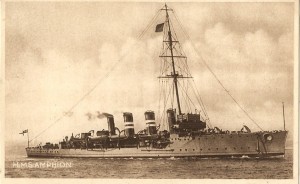 Looking back at Corbett’s writings, he talks a great deal about the need for cruisers, but technology and terminology have moved on and the cruisers of Corbett’s days are not what we think of as cruisers today. Corbett’s “Some Principles of Maritime Strategy” was published in 1911. There were some truly large cruisers built in the years leading up to World War I, but Corbett decried these in that their cost was in conflict with the cruiser’s “essential attribute of numbers.”
Looking back at Corbett’s writings, he talks a great deal about the need for cruisers, but technology and terminology have moved on and the cruisers of Corbett’s days are not what we think of as cruisers today. Corbett’s “Some Principles of Maritime Strategy” was published in 1911. There were some truly large cruisers built in the years leading up to World War I, but Corbett decried these in that their cost was in conflict with the cruiser’s “essential attribute of numbers.”
A typical cruiser that came out of the thinking of the day was the Active Class (1912). 3,440 tons, 26 knots, and ten 4″ guns. Many of the cruisers of the day were even smaller, many under 3,000 tons.
Corbett often referred back to the Nelsonian period. His idea of a cruiser was the smallest warship that could undertake prolonged independent operations, frigates, sloops of war, and brigs, even schooners. Their missions were:
- Protection of our own maritime commerce
- Denial of the enemy’s commerce, including blockade and commerce raiding
- Scouting (ISR in the current vocabulary)
- Screening the battlefleet (both anti-scouting to deny the enemy knowledge of own battlefleet and protection for the swarm of flotilla craft with torpedoes.)
- Communications
Of these he seemed to consider scouting for and screening the battlefleet, unfortunate, if necessary distractions from their primary duty of exercising control over maritime communications and commerce.
In the hundred plus years since Corbett’s writing, the number and types of naval platforms have proliferated and the roles once the exclusive domain of these relatively small surface ships have been assumed by other systems.
Radio replaced the dispatch carrying function of Nelson’s cruisers and improvements continually reduced the importance of the role for 20th century cruisers.
The torpedo boat destroyers first grew from what we would now call FACs into cruiser roles and cruiser size and now emerged as major strategic assets in their own right.
Submarines, which were little understood in Corbett’s time, quickly emerged as the premier commerce raider. Later they took on the role of countering their own kind, just as cruisers once did. They have scouted for and screened surface ships. They also grew into additional roles that make them in some respects inheritor of the battleship mantle as well as that of the cruiser.
Airplanes, also a recent innovation when Corbett wrote his classic, quickly became effective and essential scouts. They began to screen the fleet against the opposing “flotillas” including the enemies own planes. Flying from escort carriers or in the form of long-range maritime patrol aircraft that took on the cruisers role of protecting commerce. During WWII they replaced the battleships’ guns.
More recently satellites also assume roles in scouting and communications.
Small surface ships can still do the missions Corbett identified, but it seems other systems may be able to do them as well or better. Are their still roles for the smallest warships that can undertake prolonged independent operations?
There are still some things only surface ships can do. What is enemy commerce is not always obvious. In many cases only a visit and search can determine if a vessel is innocent.
While aircraft and even submarines may protect our own commerce, when ships are attacked far from shore, only surface ships (and their embarked aircraft), can save the crews or bring damage control assistance.
These are certainly not jobs for Burke class destroyers, which are now, with BMD and land attack roles, essentially Capital Ships. We need some minimum number of ships to do these tasks which are essential to the exercise of sea control. Once we establish how many we need, we can consider if the marginal cost of adding MCM, ASW, ASuW, and/or AAW capability is worthwhile. Frigates once filled this role, in addition to others, LCS are the only ships the Navy is currently building that might do these jobs. Some Coast Guard Cutters may also be appropriate. Somehow, I doubt we have enough, and I have doubts that they are adequately armed to deal with even medium sized merchant vessels without assistance.
Essentially we have a fleet of battleships of several types, CVNs, SSBNs, SSNS, DDGs, Amphibs. Simple and numerous “cruisers,” the smallest ships that can undertake prolonged independent operations, are almost non-existent.
“In no case can we exercise control by battleships alone. Their specialization has rendered them unfit for the work, and has made them too costly ever to be numerous enough. Even, therefore, if our enemy had no battle-fleet we could not make control effective with battleships alone. We should still require cruisers specialized for the work and in sufficient numbers to cover the necessary ground.”
Ref: “Some Principles of Maritime Strategy,” by Julian Stafford Corbett: http://eremita.di.uminho.pt/gutenberg/1/5/0/7/15076/15076-h/15076-h.htm
Chuck Hill is a retired Commander in the U.S. Coast Guard. He writes at Chuck Hill’s CG Blog, with the objective of looking, over the longer term, at the budgets, policies, tactics, roles, missions, and their physical expression – the platforms – that allow the Coast Guard to do its job.


 If the Conch is to have any authority, it must have a very clear effect. In Lord of the Flies, Ralph knows well that if the Conch is blown and no one comes, it loses its authority.
If the Conch is to have any authority, it must have a very clear effect. In Lord of the Flies, Ralph knows well that if the Conch is blown and no one comes, it loses its authority.